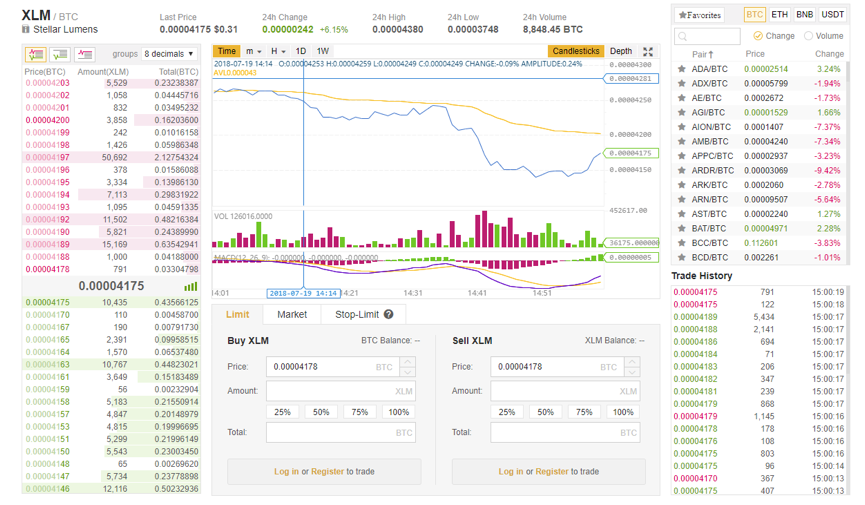Stellar (XLM) Review – A Decentralized Global Money Transfer Platform
| Stellar Key Information | |
| Name | Stellar |
| Ticker | XLM |
| Total Supply | 104,125,061,584 |
| Category | Blockchain Protocol |
| Initial Trading Price | $0.002976 |
| Website URL | Go to Stellar.org |
Stellar envisions a world where people are connected to low-cost financial services in order to fight poverty while maximizing individual potential. In line with its mission, the Stellar network is free to use for both people and businesses. With Stellar, you can do almost anything you would be able to do with a bank, without worrying about bank fees for currency exchanges. It is developing its platform with the idea of creating a worldwide financial network open to anyone.
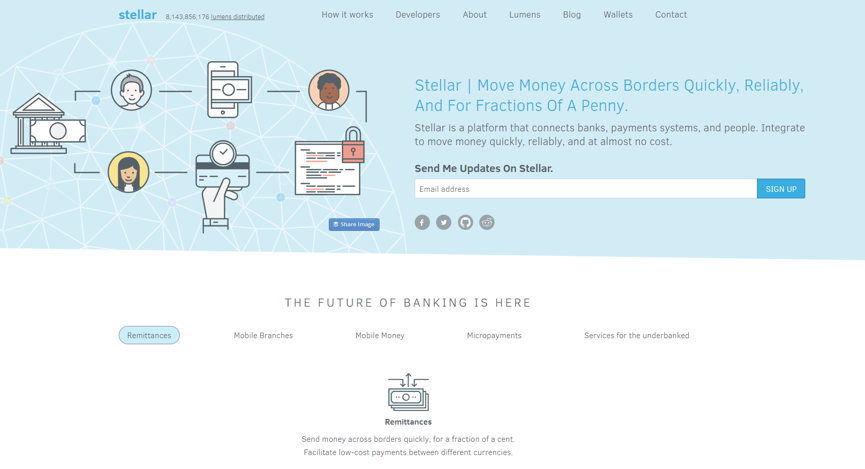
The Idea and the Team Behind Stellar
Stellar is an open, decentralized payment infrastructure that allows the unbanked to open financial accounts, affording them the opportunity to receive low-cost accounts, start micro-savings, or apply for loans. It enables multi-currency transactions quickly, reliably, and without excessing bank fees using a crypto-coin called lumens (XLM).
The Stellar Stellar Network and Protocol is being developed by the Stellar Development Foundation, incorporated in 2014 as a nonprofit entity in the state of Delaware. Its broader goal is to promote financial access, literacy and inclusion by granting low-cost financial services to populations all over the globe. At the same time, it wants to enable a framework for developers to create financial products for their own communities.
Instead of being funded by transaction fees, the network is funded though the sale of Lumens, the native asset of the Stellar network, charitable contributions from businesses or individuals, foundation membership, and a loan of $3 million from Stripe (which was already repaid with 28 Lumens). It has received funding from corporate donors such as FastForward, Google.com, and BlackRock.
The Stellar team has a wide range of experience spanning machine learning, software development and traditional finance. Jed McCaleb, according to LinkedIn, is the current director of Stellar as well as an advisor to the Machine Intelligence Research Institute. In the past, he was one of the co-founders of Ripple and held a position as the CTO at the company. Ella Qiang is the Director of Partnerships, base din China. Previously she worked as a senior financial analyst at Sunrun in San Francisco. Bartek Nowotarski has been working at Stellar Foundation as a software engineer since its launch. Previously he was a lead software engineer at Hello Social and Megafoni.

Stellar Partnerships
Stellar has a number of strategic partnerships with top corporations such as IBM. The company is currently running 8 Stellar nodes and has set up 12 currency corridors in Australasia and Oceania. It also has an important partnership with a French money transfer company, Tempo, who now has a role as an anchor to the fiat world.
In order to open more currency corridors, Stellar has increased its partnerships all over the globe. By the end of 2017 it closed 37 partnerships.
| Region | # of New Partnerships | Notable Partnerships |
| Africa | 6 |  |
| APAC | 8 | |
| Europe | 3 |   |
| Persian Gulf | 5 |  |
| Americas | 4 |   |
XLM Token Price History
Stellar launched in 2014. In 2015, its network upgraded, and stellars became lumens, or XLMs, to help separate the digital currency from the name of the network and non-profit. By the beginning of January of this year, the coin rose to $0.92.
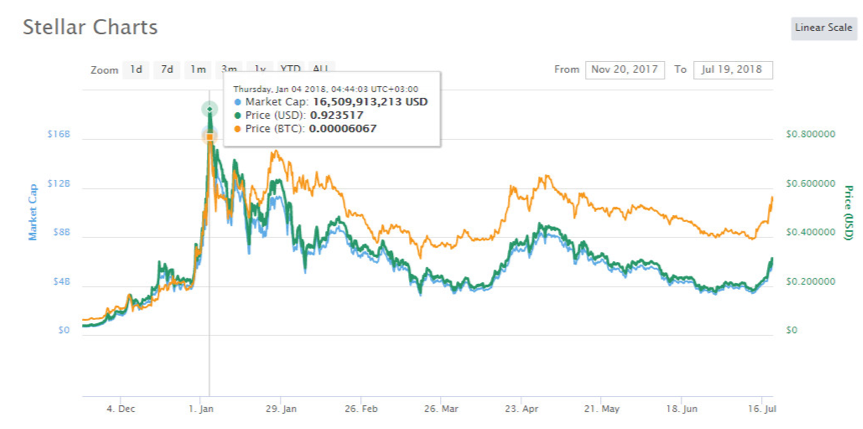
At the moment XLM is on an upwards gain after the announcement of its recent Sharia certification, news of its potential listing on Coinbase and a general upwards movement in all cryptocurrencies.
The Stellar Network
Similar to the global network servers of the internet, the Stellar network is comprised of decentralized servers all over the world that power a distributed ledger. The ledger records transactions of people and businesses, with a copy of the ledger located on each server. Consensus occurs as servers verify transactions and sync the ledger every 2-5 seconds.
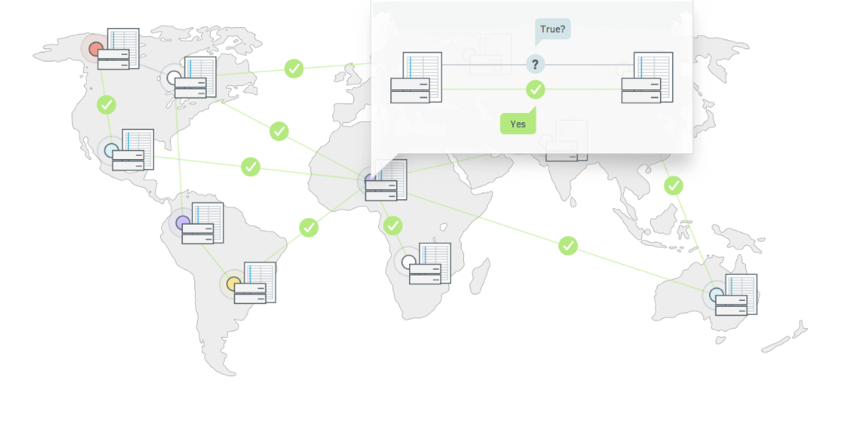
Your transactions are recorded in the ledger, including credits and debits. Money is moved through anchors (like banks and payment processors), who act as intermediaries between the Stellar network and any given currency.
When a user requests a currency, Stellar uses lumens as its intermediary for the exchange, converting them from the first currency into lumens. It then takes the lumens and converts them into the second currency automatically. If there are no available trading pairs, it finds offers on the network which will lead to that conversion (This is how it is able to trade currencies on an international scale). As a result, your online account is credited in exchange for a deposit, an exchange which can take place between any two people on the network. Transactions are available in cryptocurrency and fiat pairs.
Stellar’s distributed exchange will convert currencies automatically for the lowest rate possible. All transactions take place in 2 to 5 seconds, are cryptographically secure, and comply with regulatory compliance. With a transaction fee of $0.01 for 600,000 transactions, it’s an idea solution for micropayments.
The Stellar Lumens (XLM) Coin
Lumens, or XLM, are the native asset of the Stellar network and enable the movement of financial transactions on the network. Stellar launched in 2014 with 100 billion stellars (the original name of the network’s native asset). The supply of lumens is set according to protocol-level rules, and the inflation rate increases by 1% every year.
Lumens have two distinct purposes:
- Anti-spam – They prevent people from overwhelming the network and help the network prioritize transactions. They are also necessary for transaction fees and minimum balances on accounts. Transaction fees are 0.00001 lumens for any transaction, a fee that makes a DoS attack more difficult as it becomes expensive to flood the network with transactions. The Stellar network also requires all accounts to have a minimum balance of 0.5 lumens. The idea behind this is to encourage accounts to stay active, and have inactive accounts remove themselves from the network.
- Help facilitate multi-currency transactions – Lumens are as a bridge when a pair of currencies don’t have a large market for exchange.
Lumens were distributed as follows:
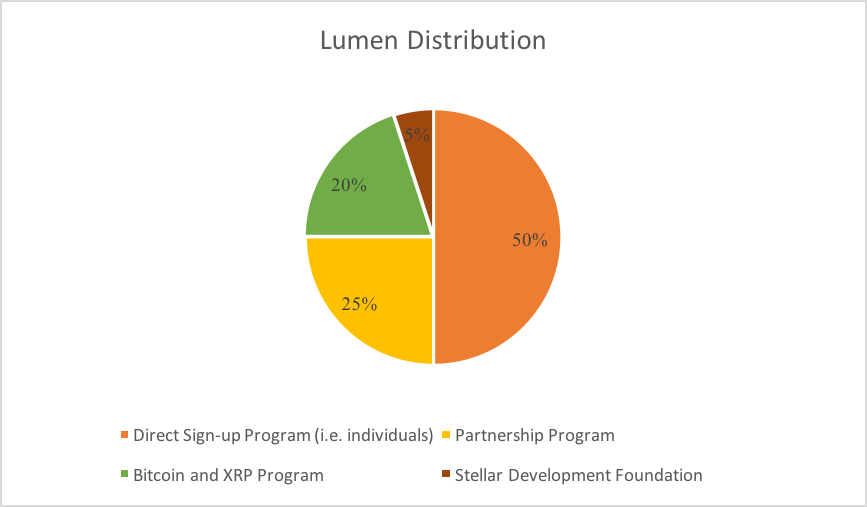
In addition, Stellar periodically gives away lumens in order to encourage communities to develop the services they need and increase the network’s utility. As of January 2018, it has given away over 8 billion lumens.
How to Purchase XLM
Since Stellar changed its ticker from STR to XLM, a few exchanges have not updated the ticker. The main exchange for purchasing XLM is on Binance, which currently has the largest exchange of the currency. XLM can be traded on Binance for BTC, USDT and ETH. At the moment the current daily volume of XLM traded on Binance is over $127 million.
XLM is also available on the following exchanges:
- Upbit (Trade XLM with KRW on Upbit)
- Poloniex (Trade STR with BTC on Poloniex)
- GOPAX (Trade XLM with KRW on GOPAX)
- Kraken (Trade XLM with EUR on Kraken)
- BCEX (Trade XLM with CKUSD on BCEX)
How to Store XLM
XLM can be stored in a variety of desktop, mobile and web wallets. Many of the wallets were built specifically to exist within Stellar’s network, like StellarTerm, Stellar Desktop Client, and the LOBSTR Stellar Wallet, which has recently been released as on iOS app.
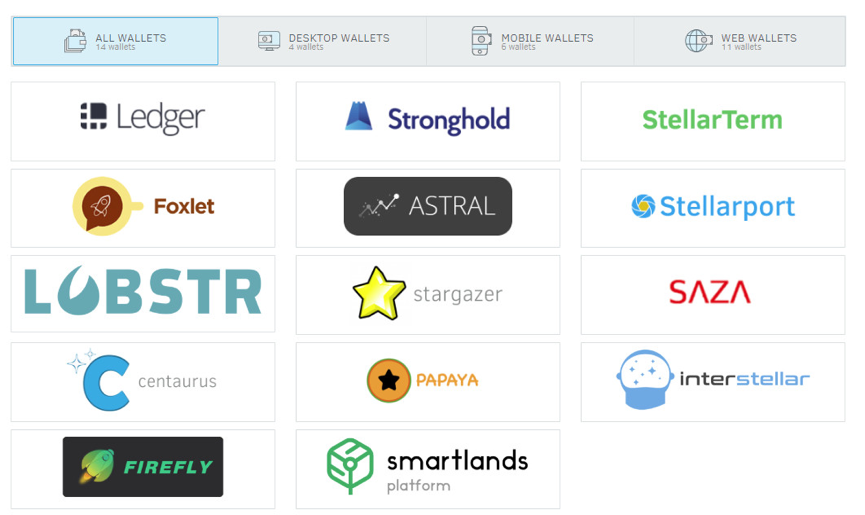
For maximum security, however, you should store your XLM on hardware wallets such as Ledger Nano S.
Roadmap and Future Plans
Stellar does not have an official roadmap, but it does announce important milestones via its social media channels and blog.
At the beginning of the year it announced a few important goals for 2018, including:
- The Stellar Decentralized Exchange (SDEX) – This would be the front-end of the Stellar technology, which would enable on-chain, protocol-level trades for any Stellar token. To promote its SDEX, Stellar will offer grants of up to $2 million for partners who can assist in increasing the quality and number of anchors and market-makers on the network.
- Lightning Network on Stellar – As it seeks to increase and enable the demand for more private channels transactions, Stellar plans to integrate Lightning in 2018. Update: It released its beta integration of Lightening in early March.
In the future, Stellar believes that it would be an idea framework for overseeing ICOs and blockchain startup fundraising, as its network is flexible and can offer transactions in various cryptocurrency and fiat payment options.

